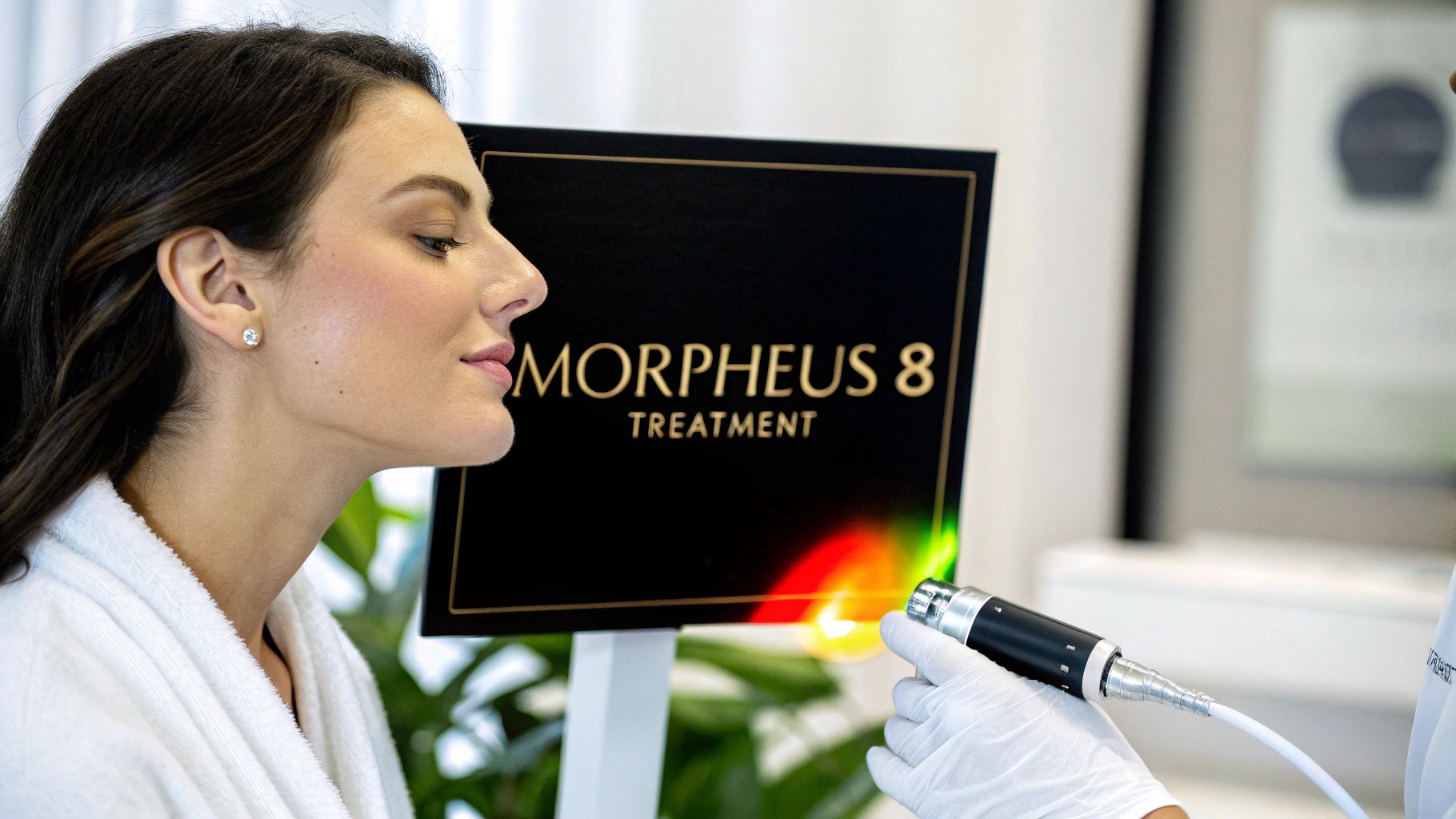
November 23, 2025
What Is Morpheus8 Treatment and How Does It Work
What is Morpheus8 treatment? Discover how this advanced RF microneedling solution revitalizes skin, its benefits, costs, and what to expect from the procedure.
Oct 9, 2025
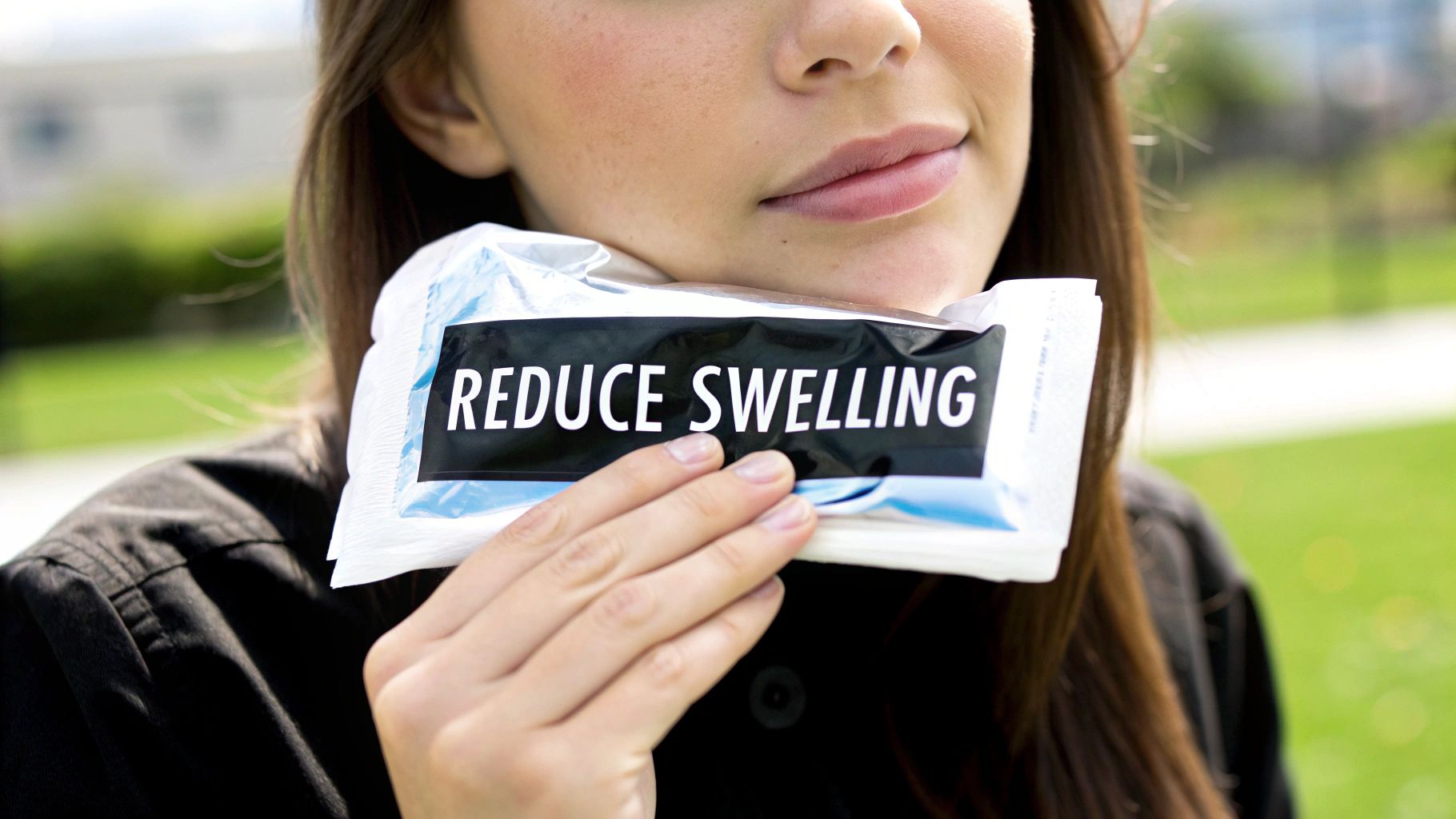
So, you're wondering how to get that lip filler swelling down? It really comes down to a mix of smart aftercare right away and a few simple lifestyle tweaks. Think cold compresses on and off, sleeping with your head propped up, and holding off on any activities that get your blood pumping for the first 48 hours.
Taking these steps helps you work with your body’s natural healing process, not against it, making your recovery much smoother and more comfortable.
First things first, let's get this out of the way: swelling after lip fillers is completely normal. In fact, you should expect it. Knowing why it happens can make the whole recovery phase feel a lot less stressful. The puffiness is simply your body's natural response to the tiny injections and the filler product itself.
What's actually going on under the surface? It's a two-part reaction.
If you're curious about the nitty-gritty of how these products work, our guide comparing Botox vs dermal fillers is a great place to dig deeper.
This infographic gives you a quick visual rundown of what to expect as the swelling goes down.
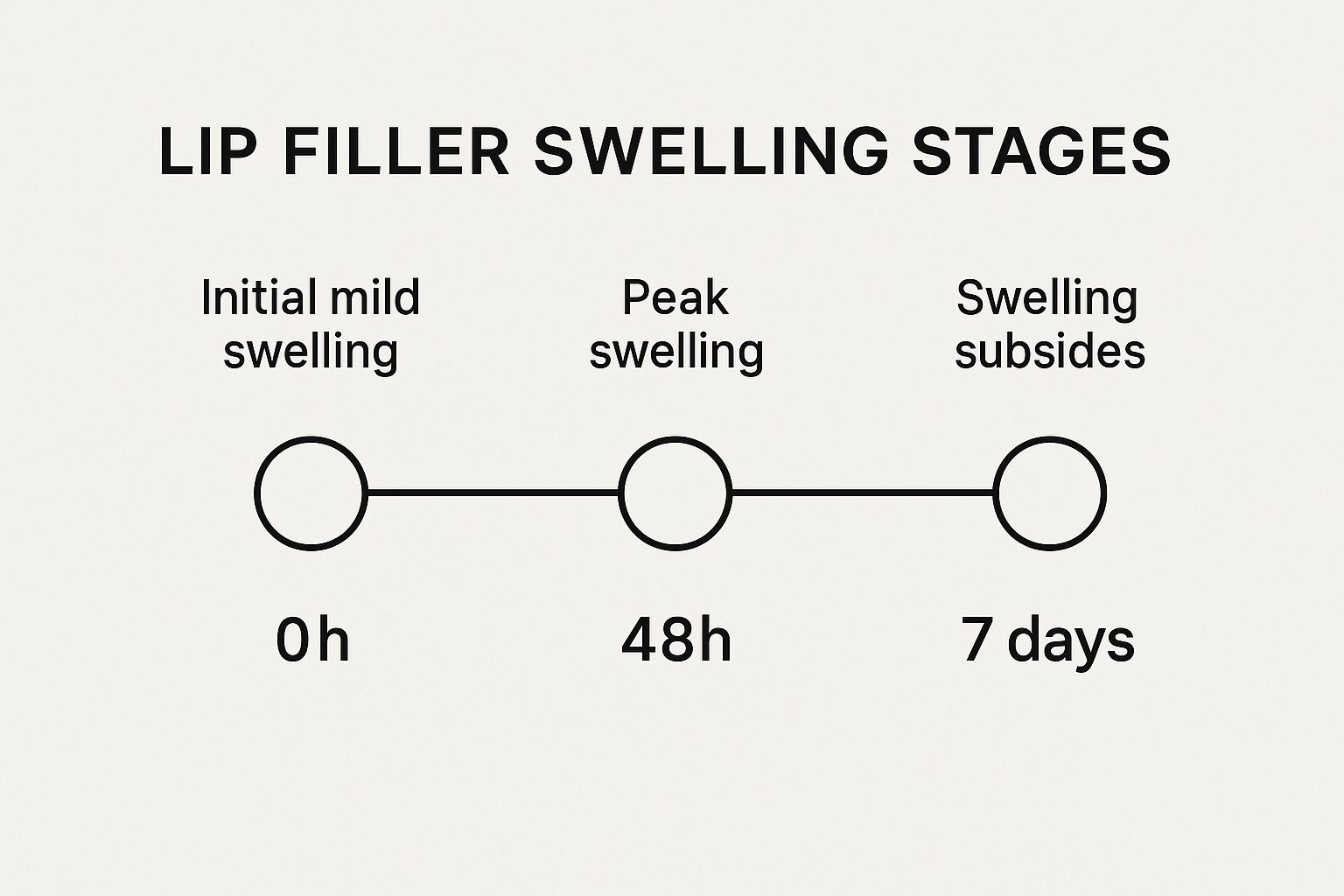
As you can see, that 48-hour mark is usually the peak. Once you're past that, things start to get much better.
Knowing what to expect day by day can be incredibly reassuring. While everyone heals a bit differently, there's a pretty standard timeline for how swelling progresses and subsides.
Lip Filler Swelling Timeline What to Expect Day-by-Day
Remember, this is a general guide. Factors like how much filler was used and your own body's response play a huge role. But by the end of that first week, the worst is almost always over. That initial puffiness is just a temporary stop on the way to your final, gorgeous result.
Let's be clear: the first two days after getting your lips done are absolutely crucial. This is when swelling is at its peak, and what you do during this window can make a huge difference in how quickly that puffiness goes down. Think of it as setting the stage for a calm, comfortable healing process.
These initial steps aren't just suggestions; they are the foundation for getting the best, most beautiful results from your treatment.

For the first 48 hours, a cold compress will be your absolute best friend. The chill helps constrict blood vessels, which is exactly what you want—it slows blood flow to the area, keeping both swelling and bruising in check. But you have to do it right.
Never, ever put ice directly on your lips. The skin there is far too delicate. Instead, grab a soft gel pack from the freezer or wrap a few ice cubes in a clean, thin towel or cloth.
Gently hold the compress against your lips for about 10 minutes at a time, then give your skin a 10-minute break. This on-and-off routine is key; it delivers all the anti-inflammatory goodness without risking damage to your skin from the cold. Feel free to repeat this cycle as often as you can throughout the day.
Expert Insight: Consistent, gentle icing is the single most effective thing you can do. Clinical evidence shows that using a cold compress can shorten the duration of swelling by nearly 30% and reduce its severity by up to 40%.
Gravity is a surprisingly powerful ally in your recovery. When you lie down flat, fluid has a tendency to pool in your face, which is why you often wake up looking puffier than when you went to bed.
The fix is incredibly simple. For the first few nights, prop your head up with an extra pillow or two. This small change helps fluid drain away from your lips while you sleep, significantly reducing that morning swelling. It’s a low-effort move that delivers a high-impact result.
Your main goal for the first 48 hours is to keep your body calm and avoid anything that significantly increases blood flow to your face. More blood flow means more swelling—it’s that straightforward.
So, for the next two days, you’ll want to take a temporary break from:
Remember, clinical experience shows that 70-85% of patients see swelling peak within these first two days. By taking it easy and following these steps, you’re giving your body the best possible chance to heal quickly and beautifully. You can get a more detailed timeline of what to expect from swelling and bruising after lip fillers on TheGillCenter.com.
You might be surprised to learn just how much your diet can influence your recovery after getting lip fillers. What you eat and drink in the days following your appointment can either help calm the swelling or make it worse. A few thoughtful choices can make a real difference in how quickly that puffiness goes down.

First things first: hydrate, hydrate, hydrate. Your goal should be 8 to 10 glasses of water a day. Staying well-hydrated is one of the simplest and most effective ways to help your body flush out the excess fluid that causes swelling.
Beyond just water, the food you put on your plate plays a big role. Some foods are natural inflammation fighters, while others can unfortunately aggravate the swelling.
I also recommend steering clear of very hot or spicy foods for the first 48 hours. They can increase blood flow to the area and potentially make the swelling a bit more noticeable.
For an extra healing boost, you could look into natural anti-inflammatory supplements like green-lipped mussel extract. Some of my clients find these can give their body’s natural response a helpful nudge.
Ultimately, being mindful of your diet gives you a bit of control over the healing process. These simple swaps, paired with a real focus on hydration, are powerful tools for getting you past the swelling and enjoying your beautiful new results sooner.
You'd be surprised how much of a difference a few small tweaks to your routine can make in that first week. When it comes to managing lip filler swelling, it's often the simplest, most practical changes that give you the biggest bang for your buck by supporting your body's natural healing process.

One of the most effective things you can do? Change how you sleep. For the first few nights, prop your head up with an extra pillow. This simple adjustment uses gravity to help drain fluid away from your face instead of letting it pool in your lips overnight. You'll wake up with noticeably less puffiness.
Beyond your sleeping position, it’s all about avoiding anything that puts direct pressure on your newly treated lips. This is a crucial step to let the filler settle properly and keep any extra swelling at bay.
For the first 2-3 days, try your best to steer clear of:
You'll also want to be gentle with your skincare routine. Cleanse the area carefully and definitely skip any harsh exfoliants or scrubs on or around your lips for about a week.
One of the most overlooked tips I give my clients is to stay out of the sun. Direct sun exposure can actually prolong inflammation. For the first week, just pop on a wide-brimmed hat when you go outside to shield the delicate tissue.
Ultimately, the best thing you can do is be patient. These minor adjustments help create the perfect environment for healing, so you can see those beautiful final results that much sooner.
A bit of puffiness after your lip filler appointment is totally normal. It’s part of the process. The key is knowing what to expect during healing versus what signals a need to check in with your provider. This isn't about causing alarm; it's about giving you the confidence to know what you're seeing in the mirror is A-okay.
So, what's typical? You can expect some tenderness, maybe a little bruising right where the needle went in, and a certain firmness to your lips. It's also incredibly common for them to look a touch uneven for the first few days. Don't panic! Different spots just heal at their own pace.
Now, let's talk about the red flags. These are the signs that are not part of the standard healing playbook and mean it's time to contact your injector, just to be safe.
Keep a close eye out for these specific symptoms:
These symptoms could point to more serious issues that need to be addressed. For a more complete overview of what can happen, our guide on potential dermal filler side effects is a great resource.
Here's the golden rule of aftercare, and it's a simple one: when in doubt, make the call. Your injector is your partner in this. Keeping their number handy and reaching out with any concern is always the best move for your health and your peace of mind.
Most of the time, swelling is gone within 5 to 14 days. However, it’s worth knowing that complications, while rare, can sometimes pop up later. In about 1-3% of patients, persistent swelling or inflammatory nodules might develop weeks or even months after the treatment, as noted in a clinical review on delayed swelling complications on PMC.ncbi.nlm.nih.gov.
It's completely normal to have questions swirling in your mind after a lip filler treatment. Knowing what to expect during the healing process can make all the difference, helping you feel calm and confident as your new look settles in. Let's walk through some of the most common concerns we hear from our patients.
Yes, absolutely. In fact, it's one of the most common things people notice. Don't panic if you look in the mirror and see one side is puffier than the other.
This can happen for a couple of reasons. Maybe one side needed a tiny bit more product to achieve the desired symmetry, or it could just be your body's unique healing process at play. This kind of asymmetry almost always evens out on its own as the swelling goes down over the first week or two.
If you’re past the 14-day mark and still see a noticeable imbalance, that's the time to check in. Of course, if you're worried about anything before then, please contact our office so we can put your mind at ease.
For any post-treatment tenderness, stick with acetaminophen (Tylenol). It’s your safest bet.
It's really important to steer clear of blood-thinning pain relievers for at least 24-48 hours. This includes common medications like:
These can make bruising and swelling worse, which is the last thing you want.
For the first few days, your lips are going to feel a bit strange—firm, maybe a little lumpy, and obviously swollen. This is a standard part of the process as the filler begins to settle. Most of that initial firmness and puffiness will fade within the first week.
The real magic happens over the next few weeks. It typically takes about two to four weeks for the hyaluronic acid to fully integrate with your own tissue. This is when your lips will start to feel soft, supple, and completely natural.
Your provider might even suggest a gentle massage technique after a few days to help smooth everything out. Trust the process and be patient. Following your aftercare instructions is the best way to ensure you get that beautiful, soft result you're looking for.
Ready to achieve your aesthetic goals with the guidance of an expert? Trust Cape Cod Plastic Surgery for personalized care and beautiful, natural-looking results. Schedule your consultation today

November 23, 2025
What is Morpheus8 treatment? Discover how this advanced RF microneedling solution revitalizes skin, its benefits, costs, and what to expect from the procedure.
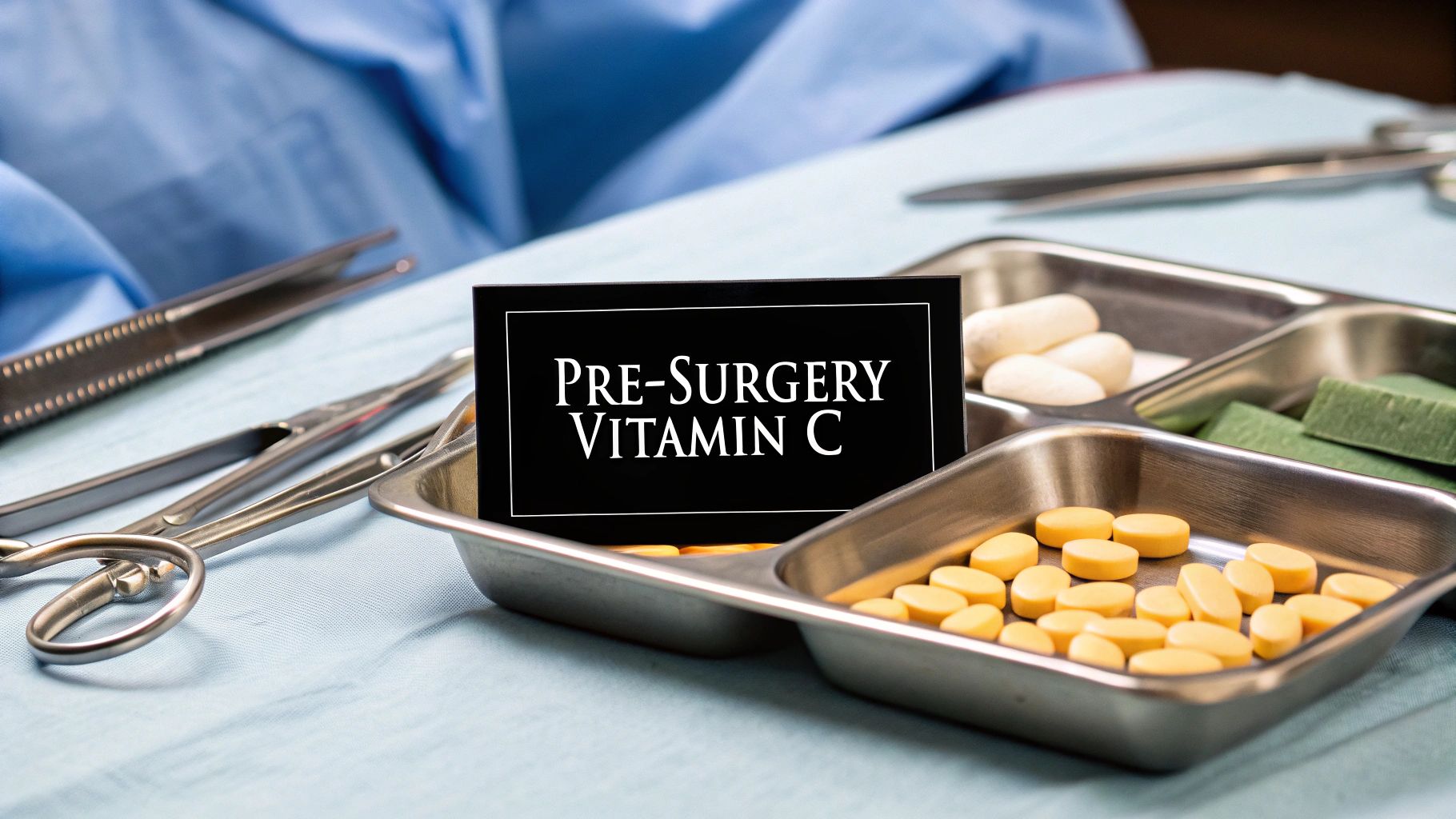
November 22, 2025
Considering vitamin C before surgery? This guide covers the science-backed benefits for healing, potential risks, and crucial advice from surgeons.
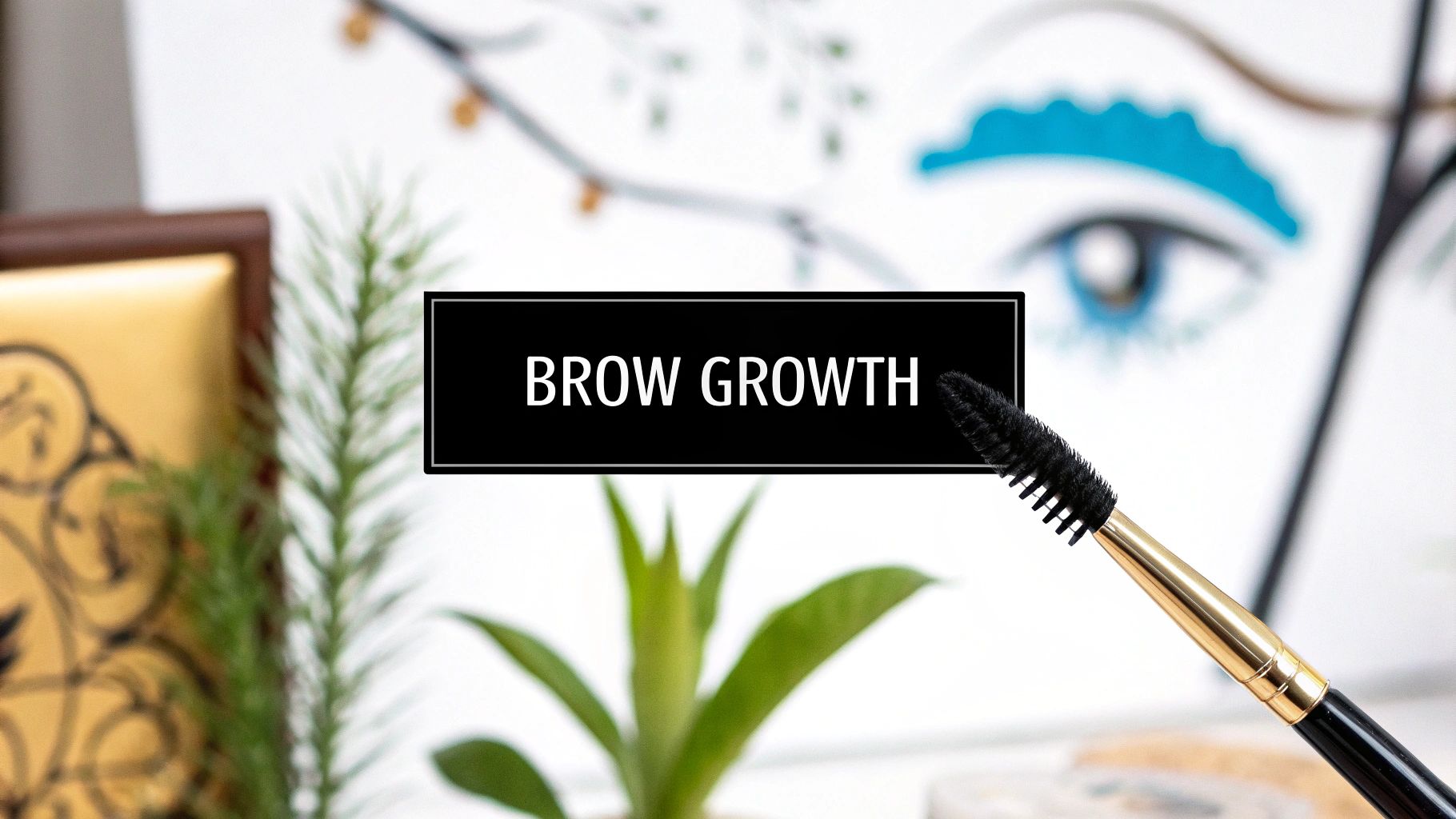
November 21, 2025
Does Latisse work for eyebrows? Get the science-backed answer. We explore results, proper use, side effects, and what to expect from this popular treatment.